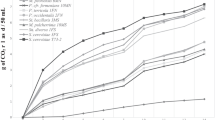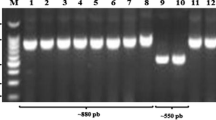Abstract
In this work, 74 Saccharomyces cerevisiae strains isolated from cachaça fermentation of six different geographic regions in Brazil were characterized by mitochondrial DNA restriction fragment length polymorphism (mtDNA-RFLP) and by their ability to grow on stress conditions occurring during the cachaça fermentation process. Cachaça S. cerevisiae strains showed high mtDNA-RFLP polymorphism with the occurrence of 32 different molecular patterns. The S. cerevisiae strains presenting prevalent mtDNA were able to grow better in the stress conditions than strains represented by infrequent patterns. The principal coordinate analysis on 17 stress conditions revealed that the major source of growth variation were high ethanol concentrations and low temperatures. These results indicate that the stress conditions occurring in the fermentation process influence the prevalence of the most adapted S. cerevisiae strains in each distillery. The physiological tests used in our study can be used as a criterion for rapidly selecting autochthonous yeast strains for further purposes such as the selection of fermentative starters of S. cerevisiae strains.



Similar content being viewed by others
References
Araújo RAC, Gomes FCO, Moreira ESA, Cisalpino PS, Rosa CA (2007) Monitoring Saccharomyces cerevisiae populations by mtDNA restriction analysis and other molecular typing methods during spontaneous fermentation for production of the artisanal cachaça. Braz J Microbiol 38:217–223. doi:10.1590/S1517-83822007000200006
Belloch C, Orlic S, Barrio E, Querol A (2008) Fermentative stress adaptation of hybrids within the Saccharomyces sensu stricto complex. Int J Food Microbiol 122:188–195. doi:10.1016/j.ijfoodmicro.2007.11.083
Brown SW, Oliver SG, Harrison DEF, Righelato RC (1981) Ethanol inhibition of yeast grown and fermentation: differences in the magnitude and complexity of the effect. Eur J Appl Microbiol Biotechnol 11:151–155
Carrasco P, Querol A, del Olmo M (2001) Analysis of stress resistance of commercial wine yeast strains. Arch Microbiol 175:450–457. doi:10.1007/s002030100289
de Llanos R, Fernández-Espinar MT, Querol A (2006) A comparison of clinical and food Saccharomyces cerevisiae isolates on the basis of potential virulence factors. Antonie van Leeuwenhoek 90:221–231. doi:10.1007/s10482-006-9077-7
Garay-Arroyo A, Covarrubias AA, Clark I, Niño I, Gosset G, Martinez A (2004) Response to different environmental stress conditions of industrial and laboratory Saccharomyces cerevisiae strains. Appl Microbiol Biotechnol 63:734–741. doi:10.1007/s00253-003-1414-4
Gomes FCO, Silva CLC, Marini MM, Oliveira ES, Rosa CA (2007) Use of selected indigenous Saccharomyces cerevisiae strains for the production of the traditional cachaça in Brazil. J Appl Microbiol 103:2438–2447. doi:10.1111/j.1365-2672.2007.03486.x
Guerra JB, Araújo RAC, Pataro C, Franco GR, Moreira ESA, Mendonça-Hagler LC, Rosa CA (2001) Genetic diversity of Saccharomyces cerevisiae strains during the 24 h fermentative cycle for the production of the artisanal Brazilian cachaça. Lett Appl Microbiol 33:106–111. doi:10.1046/j.1472-765x.2001.00959.x
Guillamón JM, Barrio E, Querol A (1996) Characterization of wine yeast strains of the Saccharomyces genus on the basis of molecular markers: relationship between distance and geographic or ecological origin. Syst Appl Microbiol 19:122–132
Kishimoto M, Goto S (1995) Growth temperature and electrophoretic karyotype as tools for practical discrimination of S. bayanus and S. cerevisiae. J Gen Appl Microbiol 41:239–247
Kurtzman CP, Fell JW (1998) The yeasts, a taxonomic study. Elsevier, Amsterdam
Lafon-Lafourcade S (1983) Wine and brandy. In: Rehm HJ, Reed G (eds) Biotechnology, vol. 5. Food and feed production with microorganisms. Verlag Chemie, Weinheim, pp 81–163
Larue F, Lafon-Lafourcade S, Ribéreau-Gayon P (1980) Relationship between the sterol content of yeast cells and their fermentation activity in grape must. Appl Environ Microbiol 66:4456–4461
Martini A, Vaughan-Martini A (1990) Grape must fermentation: past and present. In: Spencer JFT, Spencer M (eds) Yeast technology. Springer, Germany, pp 105–123
Molina AM, Swiegers JH, Varela C, Pretorius IS, Agosin E (2007) Influence of wine fermentation temperature on the synthesis of yeast-derived volatile aroma compounds. Appl Microbiol Biotechnol 77:675–687. doi:10.1007/s00253-007-1194-3
Morais PB, Rosa CA, Linardi VR, Pataro C, Maia ABRA (1997) Characterization and succession of yeast populations associated with spontaneous fermentations during the production of Brazilian sugar-cane aguardente. World J Microbiol Biotechnol 13:241–243
Nadal D, Colomer B, Pina B (1996) Molecular polymorphism distribution in phenotypically distinct populations of wine yeast strains. Appl Environ Microbiol 62:1944–1950
Naumov GI (1996) Genetic identification of biological species in the Saccharomyces sensu stricto complex. J Ind Microbiol 17:295–302
Ogawa Y, Nitta A, Uchiyama H, Imamura T, Shimoi H, Ito K (2000) Tolerance mechanism of the ethanol tolerant mutant of sake yeast. J Biosci Bioeng 90:313–320. doi:10.1016/S1389-1723(00)80087-0
Pataro C, Santos A, Corrêa SR, Morais PB, Linardi VR, Rosa CA (1998) Physiological characterization of yeasts isolated from artisanal fermentation in an aguardente distillery. Rev. Microbiol. 29:104–108
Pataro C, Guerra JB, Petrillo-Peixoto ML, Mendonça-Hagler LC, Linardi VR, Rosa CA (2000) Yeast communities and genetic polymorphism of Saccharomyces cerevisiae strains associated with artisanal fermentation in Brazil. J Appl Microbiol 88:1–9. doi:10.1046/j.1365-2672.2000.01092.x
Pataro C, Guerra JB, Neves MJ, Pimentel PF, Rosa CA (2002) Trehalose accumulation, invertase activity and physiological characteristics of yeasts isolated from 24 h fermentative cycles during the artisanal Brazilian cachaça. Braz J Microbiol 33:202–208. doi:10.1590/S1517-83822002000300003
Pretorius IS (2000) Tailoring wine yeast for the new millennium: novel approaches to the ancient art of winemaking. Yeast 16:675–729. doi:10.1002/1097-006120000615
Querol A, Barrio E, Huerta T, Ramón D (1992) Molecular monitoring of wine fermentations conducted by active dry yeasts strains. Appl Environ Microbiol 58:2948–2953
Querol A, Barrio E, Ramón D (1994) Population dynamics of natural Saccharomyces strains during wine fermentation. Int J Food Microbiol 21:315–323. doi:10.1016/0168-1605(94)90061-2
Rosa CA, Soares AM, Faria JB (2009) Cachaça production. In: Ingledew WM (ed) The alcohol textbook, 5th edn. Nottingham University, Nottingham
Schwan RF, Mendonça AT, Silva JJ Jr, Rodrigues V, Wheals AE (2001) Microbiology and physiology of cachaça fermentations. Antonie van Leeuwenhoek 79:89–96. doi:10.1023/A:1010225117654
Vianna CR, Silva CLC, Neves MJ, Rosa CA (2008) Saccharomyces cerevisiae strains from traditional fermentations of Brazilian cachaça: trehalose metabolism, heat and ethanol resistance. Antonie van Leeuwenhoek 93:205–217
Yarrow D (1998) Methods for the isolation, maintenance and identification of yeasts. In: Kurtzman CP, Fell JW (eds) The yeasts a taxonomic study. Elsevier, Amsterdam, pp 77–100
Zuzuarregui A, del Olmo M (2004) Analyses of stress resistance under laboratory conditions constitute a suitable criterion for wine yeast selection. Antonie van Leeuwenhoek 85:271–280. doi:10.1023/B:ANTO.0000020162.21248.53
Acknowledgments
This work was supported by CICYT grants AGL2006-12703-CO2-01 and AGL2007-65498-C02-02 from the Spanish Ministry of Science and Technology. We also thank to Programme ALBAN, Conselho Nacional de Desenvolvimento Científico e Tecnológico (CNPq) and Fundação de Amparo à Pesquisa do estado de Minas Gerais (FAPEMIG) for finnancial support.
Conflict of interest
The authors declare that they have no conflict of interest.
Author information
Authors and Affiliations
Corresponding author
Rights and permissions
About this article
Cite this article
Badotti, F., Belloch, C., Rosa, C.A. et al. Physiological and molecular characterisation of Saccharomyces cerevisiae cachaça strains isolated from different geographic regions in Brazil. World J Microbiol Biotechnol 26, 579–587 (2010). https://doi.org/10.1007/s11274-009-0206-0
Received:
Accepted:
Published:
Issue Date:
DOI: https://doi.org/10.1007/s11274-009-0206-0




